
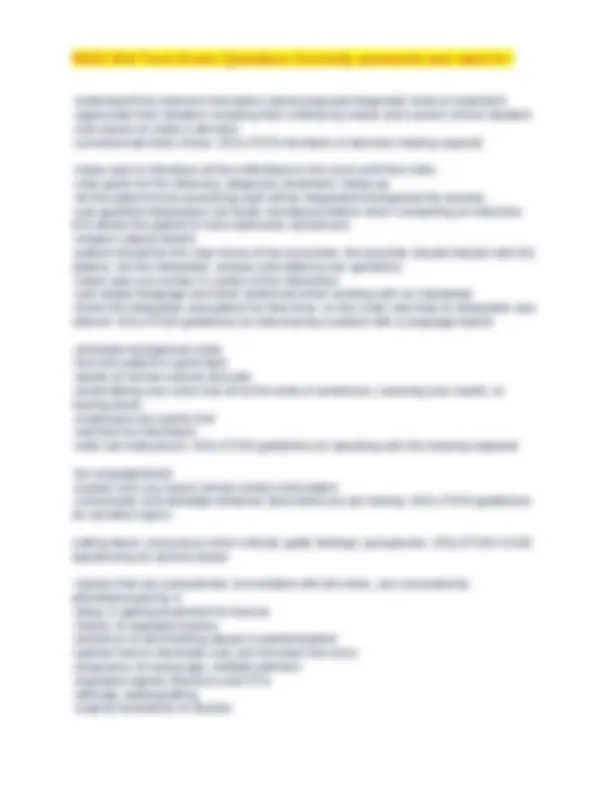
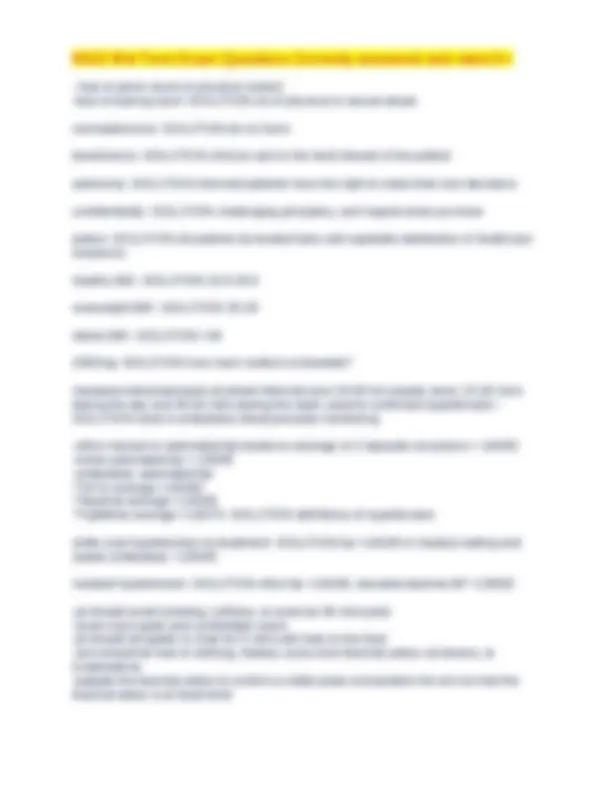
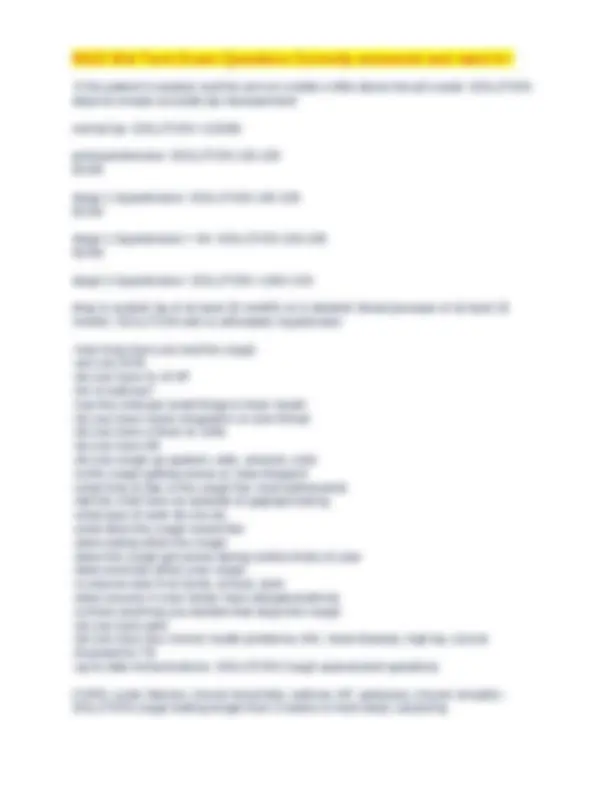
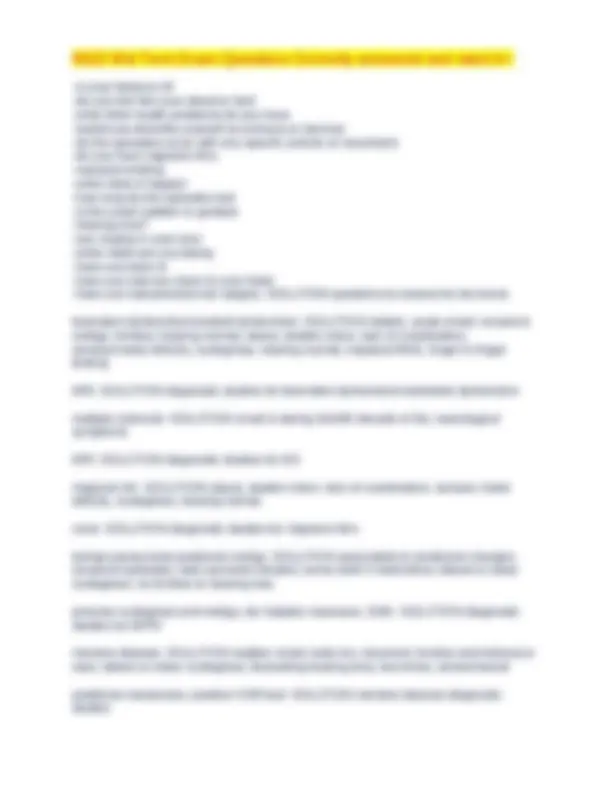
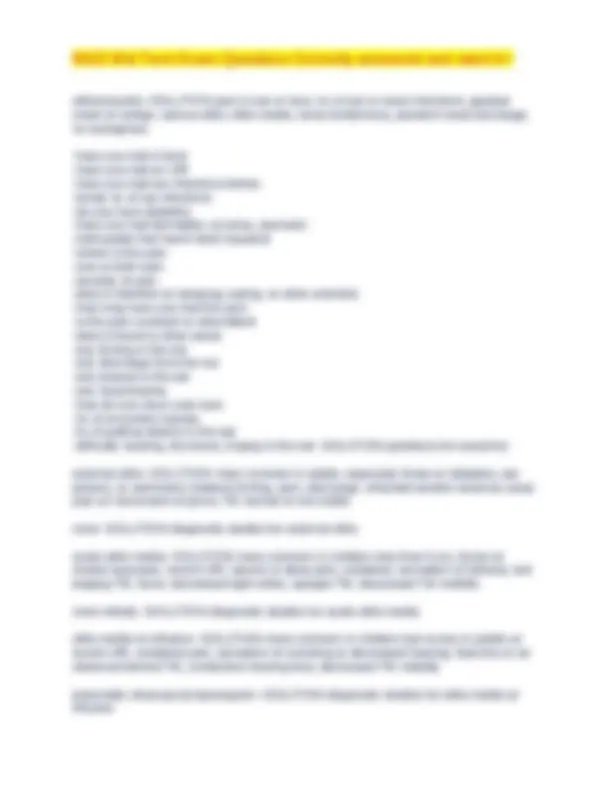
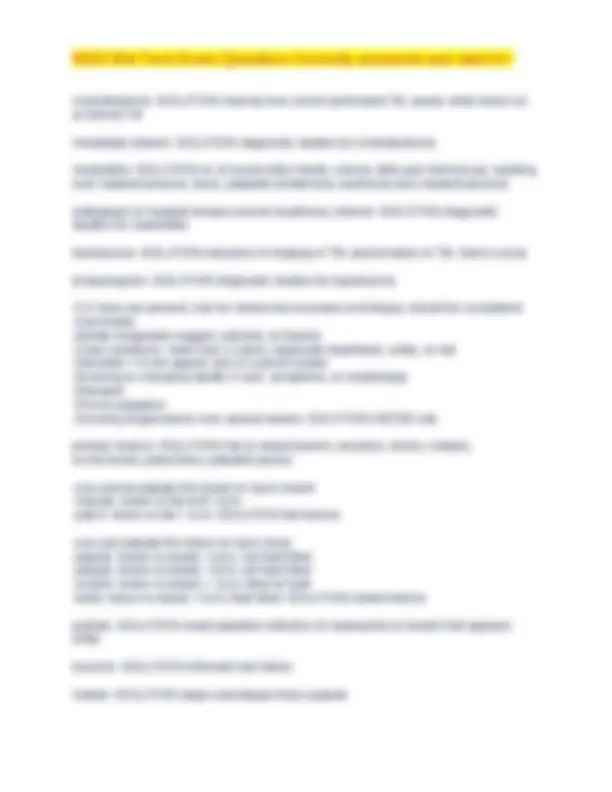
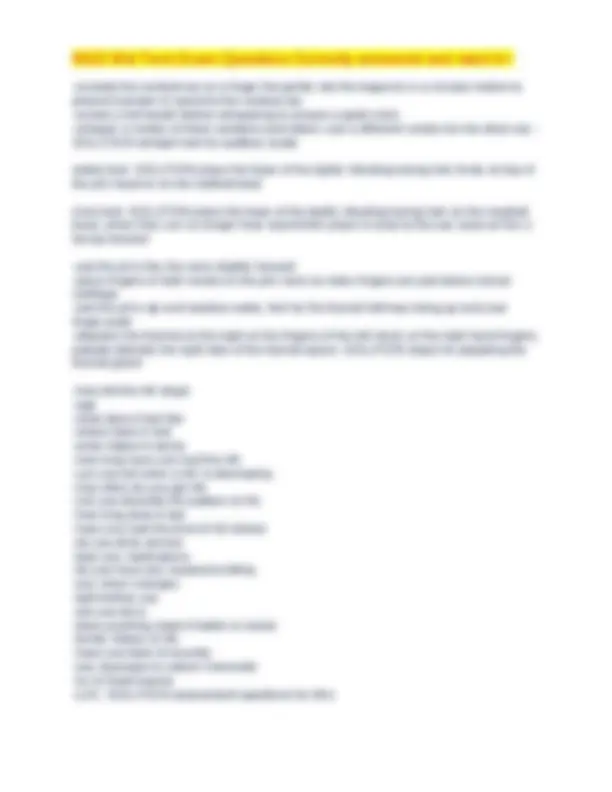
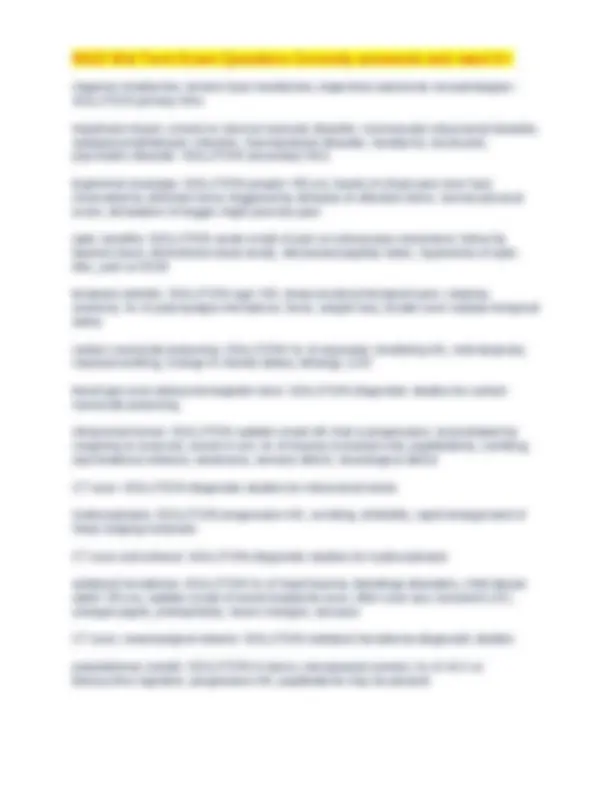
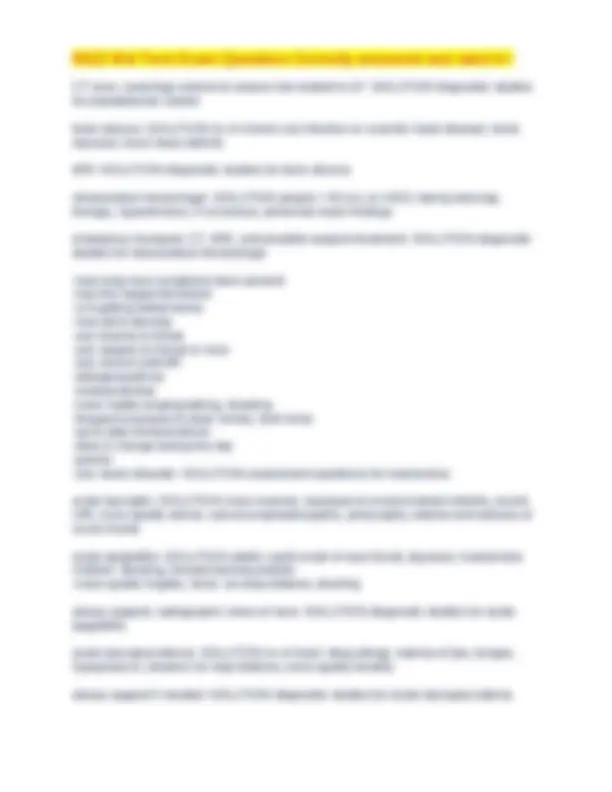

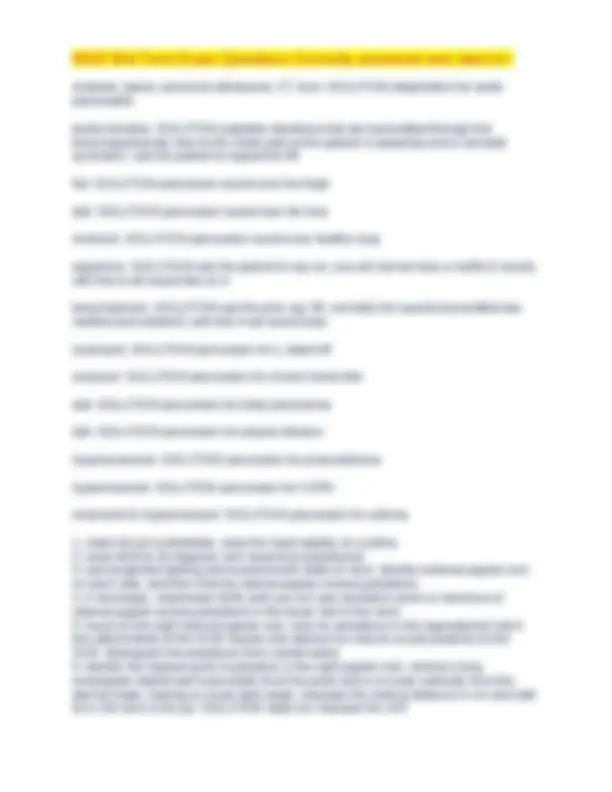
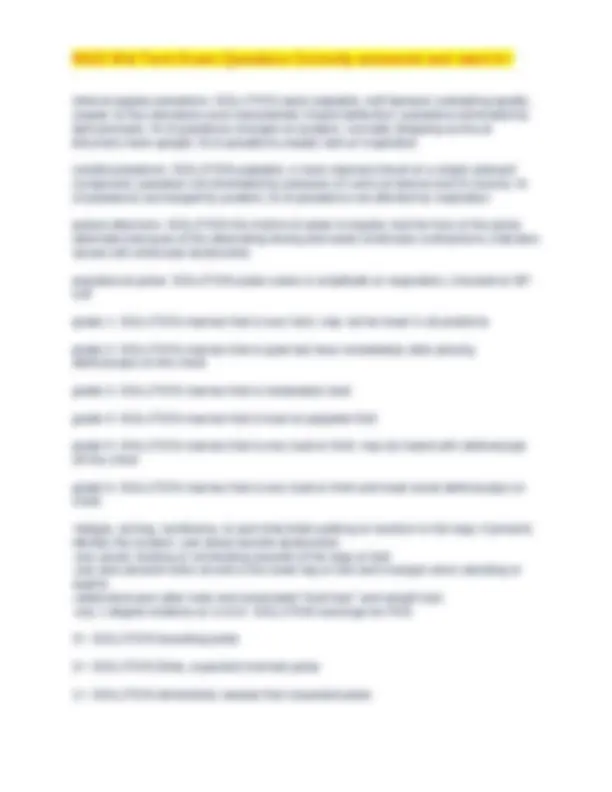
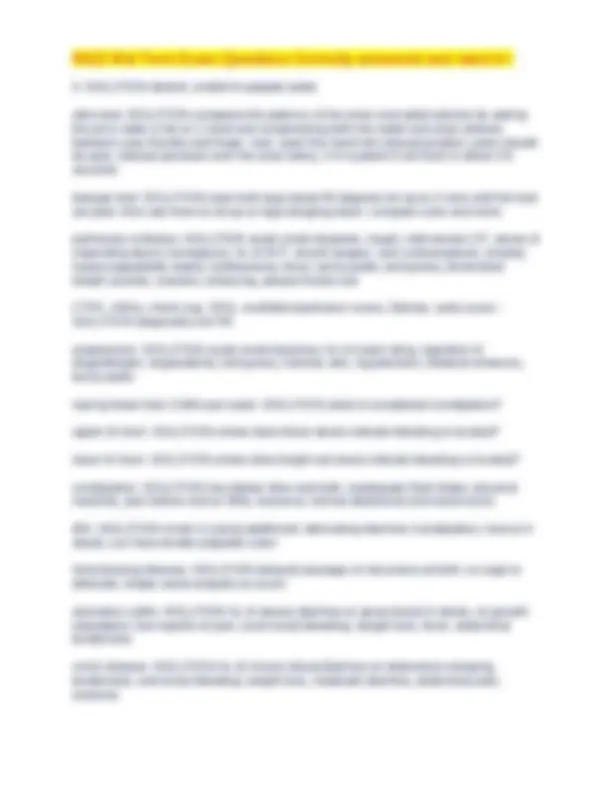
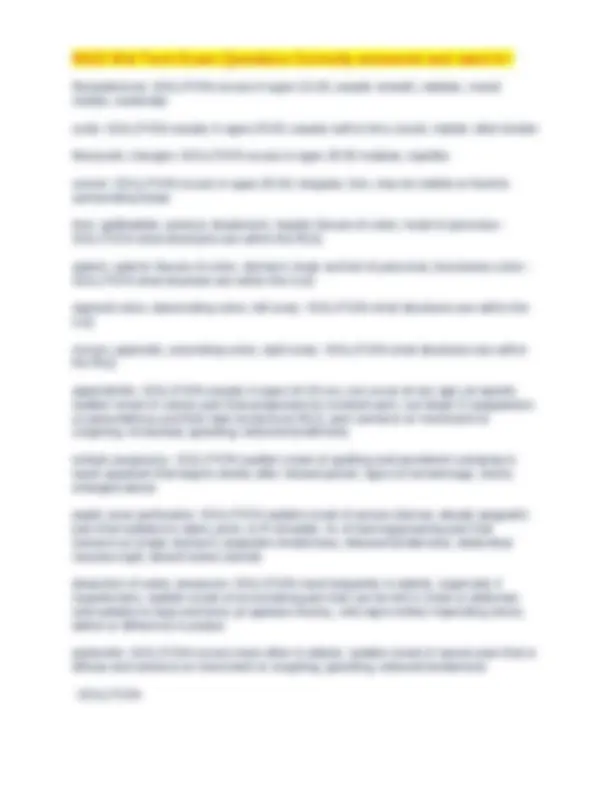


Study with the several resources on Docsity

Earn points by helping other students or get them with a premium plan


Prepare for your exams
Study with the several resources on Docsity

Earn points to download
Earn points by helping other students or get them with a premium plan
Community
Ask the community for help and clear up your study doubts
Discover the best universities in your country according to Docsity users
Free resources
Download our free guides on studying techniques, anxiety management strategies, and thesis advice from Docsity tutors
An overview of the diagnostic studies and assessment questions for various medical conditions, including mycoplasma pneumonia, rsv/bronchiolitis, chronic bronchitis, cystic fibrosis, tuberculosis, multiple sclerosis, migraine headaches, benign paroxysmal positional vertigo, meniere's disease, otitis/sinusitis, external otitis, acute otitis media, otitis media with effusion, primary and secondary headaches, trigeminal neuralgia, optic neuritis, temporal arteritis, carbon monoxide poisoning, stable angina, myocarditis, pericarditis, aortic stenosis, mitral valve prolapse, pleuritis, esophagitis, herpes zoster, peptic ulcer disease, cholecystitis, acute pancreatitis, appendicitis, ectopic pregnancy, and aortic aneurysm dissection. The key symptoms, diagnostic studies, and assessment questions for each condition, providing a comprehensive resource for healthcare professionals.
Typology: Exams
1 / 22

This page cannot be seen from the preview
Don't miss anything!















diagnostic reasoning -SOLUTION a scientific process in which the practitioner suspects the cause of a patient's symptoms and signs based on previous knowledge Character-how does it look/feel/smell/sound Onset-when did it start Location Duration-how long does it last, recurrent Severity- scale 0- Pattern- what makes it worse/better Associated factors-other symptoms, interfere w/ ADLs -SOLUTION What is symptom analysis using COLDSPA clinical reasoning -SOLUTION situation, practice-based form of reasoning that acknowledges the many variables that are present in an actual clinical situation, such as social relationships/situations involving family, community and team of healthcare providers evidence-based practice -SOLUTION integration of clinical expertise with the most current, relevant, and sound research evidence to guide clinical practice decisions comprehensive assessment -SOLUTION all the elements of the health history and complete physical examination focused/problem oriented assessment -SOLUTION addresses focused concerns/symptoms, restricted to body system, applies examination methods relevant to assessing the concern subjective data -SOLUTION what the patient tells you; symptoms and history from chief complaint through review of systems objective data -SOLUTION what you detect during examination, lab findings, and test data. all physical exam findings. identifying data/source of history and reliability, chief complaint, present illness, past history, family history, personal and social history, review of systems -SOLUTION components of the comprehensive health history location, quality, quantity/severity, timing, setting, relieving and aggravating factors, associated manifestations -SOLUTION 7 attributes of a symptom inspection -SOLUTION close observation of the details of the patient's appearance, behavior, and movement palpation -SOLUTION tactile pressure from the palmar fingers or fingerpads to assess areas of skin elevation, depression, warmth, tenderness, lymph nodes, pulses, contours, sizes of organs, masses, crepitus
percussion -SOLUTION use of striking usually the third digit to deliver a rapid to tap to other 3rd digit against the chest or abdomen to evoke a sound auscultation -SOLUTION use of diaphragm and bell of stethoscope to detect characteristics of heart, lung, bowel sounds general survey -SOLUTION observe the patient's general state of health, ht, wt, build, and sexual development. note posture, motor activity, gait, personal hygiene, facial expressions, tone differential diagnosis -SOLUTION a list of potential causes for the patient's problems primary prevention -SOLUTION interventions designed to prevent disease secondary prevention -SOLUTION screening tests designed to find disease or disease processes at an early, asymptomatic age patient-centered interviewing -SOLUTION following the patient's lead to understand their thoughts, ideas, concerns, and request, without adding additional information from the clinician's perspective symptom focused, clinician centered -SOLUTION clinician takes charge of the interaction to meet their own needs to acquire the symptoms, details, and other data to identify the disease moving from open-ended to focused questions, using questions to elicit a graded response, asking a series of questions one at a time, offering multiple choices for answers, clarifying what the patient means, encouraging with continuers, using echoing -SOLUTION techniques of guided questioning evoke the patient's perspective, convey interest in the person not just the problem, follow the patient's leads, elicit and validate emotional content, share information w/ the pt, make clinical reasoning transparent to the patient, reveal the limits of your knowledge -SOLUTION techniques for empowering the patient cultural competence -SOLUTION a set of attitudes, skills, behaviors, and policies that enable organizations and staff to work effectively in cross-cultural situations. it reflects the ability to acquire and use knowledge of the health related beliefs, attitudes, practices, and communication patterns of clients/families to improve services, strengthen programs, increase community involvement, and close gaps in health status among diverse population groups capacity -SOLUTION clinical designation and can only be assessed by clinicians competence -SOLUTION legal designation and can only be decided by court
-If the patient is seated, rest the arm on a table a little above the pt's waist -SOLUTION steps to ensure accurate bp measurement normal bp -SOLUTION <120/ prehyperstension -SOLUTION 120- 80- stage 1 hypertension -SOLUTION 140- 90- stage 1 hypertension > 60 -SOLUTION 150- 90- stage 2 hypertension -SOLUTION >160/> drop in systolic bp of at least 20 mmHG or in diastolic blood pressure of at least 10 mmHG -SOLUTION with is orthostatic hypotension -how long have you had the cough -are you SOB -do you have hx of HF -Hx of asthma? -has the child put small things in their mouth -do you have nasal congestion or sore throat -do you have a fever or chills -do you have HA -do you cough up sputum: odor, amount, color -is the cough getting worse or more frequent -what time of day is the cough the most bothersome -did the child have an episode of gaging/choking -what type of work do you do -what does the cough sound like -does eating affect the cough -does the cough get worse during certain times of year -does exercise affect your cough -is anyone else ill at home, school, work -does anyone in your family have allergies/asthma -is there anything you do/take that stops the cough -do you have pets -do you have any chronic health problems, HIV, heart disease, high bp, cancer -Exposed to TB -up to date immunizations -SOLUTION Cough assessment questions COPD, cystic fibrosis, chronic bronchitis, asthma, HF, pertussis, chronic sinusitis - SOLUTION cough lasting longer than 3 weeks is more likely caused by
chest xray is normal -SOLUTION diagnostic studies for acute bronchitis croup/acute laryngotracheobronchitis -SOLUTION history of URI; brassy barking cough usually at night; low grade fever, inspiratory stridor, flaring of nares, prolonged expiratory phase, retractions, diminished breath sounds none -SOLUTION diagnostic studies for croup/laryngotracheobronchitis postnasal drainage -SOLUTION cough, sore throat, mucoid secretions in the posterior pharynx, cobblestone appearance of the posterior pharynx, sinus tenderness, normal chest exam sinus radiographs, sinus CT scan, allergy testing -SOLUTION diagnostic studies for postnasal drainage asthma -SOLUTION dry hacking cough especially at night and w/ feeding and laughter; expiratory wheeze, prolonged expiratory phase pulmonary function testing, chest x ray, o2 sat, bronchoprovocation, allergy testing - SOLUTION diagnostic studies for asthma GERD -SOLUTION cough worse at night, sore taste in mouth, heartburn, esophagitis, smoker, alcohol abuse, overweight, dysphagia, cough after eating and lying down, vomiting, normal chest exam, normal upper respiratory tract exam, possible epigastric pain esophageal pH monitoring, blood count for anemia, xray for aspiration pneumonia, endoscopy, manometry -SOLUTION diagnostic studies for GERD chronic bronchitis -SOLUTION cough, mild dypsnea, hx of COPD, smoker, yellow sputum, hacking/rasping cough, normal breath sounds or rhonchi, resonant to dull percussion, barrel chest, wheezing chest xray, PFT -SOLUTION diagnostic studies for chronic bronchitis cystic fibrosis -SOLUTION failure to thrive, chronic cough, bulky stools, family hx, nasal polyps, clubbing fingernails, sputum tuberculosis -SOLUTION weakness, malaise, weight loss, brassy cough, possible fever, night sweats mantoux test, chest xray show abnormalities, positive sputum cultures -SOLUTION TB diagnostic studies -describe how you feel when dizzy -do you feel yourself or the room spinning
-is your balance off -do you feel like your about to faint -what other health problems do you have -would you describe yourself as anxious or nervous -do the episodes occur with any specific activity or movement -do you have migraine HAs -nausea/vomiting -when does it happen -how long do the episodes last -is the onset sudden or gradual -hearing loss? -any ringing in your ears -what meds are you taking -have you been ill -have you had any injury to your head -have you had previous ear surgery -SOLUTION questions to assess for dizziness brainstem dysfunction/cerebell dysfunction -SOLUTION elderly; acute-onset; recurrent vertigo; tinnitus; hearing normal; ataxia, double vision, lack of coordination, sensory/motor deficits, nystagmus, hearing normal, impaired RAM, finger to finger testing MRI -SOLUTION diagnostic studies for brainstem dysfunction/cerebellar dysfunction multiple sclerosis -SOLUTION onset is during 3rd/4th decade of life; neurological symptoms MRI -SOLUTION diagnostic studies for MS migraine HA -SOLUTION ataxia, double vision, lack of coordination, sensory motor deficits, nystagmus, hearing normal none -SOLUTION diagnostic studies for migraine HAs benign paroxysmal positional vertigo -SOLUTION associated w/ positional changes; recurrent episodes; lasts seconds-minutes; some relief if motionless; lateral or rotary nystagmus; no tinnitus or hearing loss provoke nystagmus and vertigo, dix hallpike maneuver, ENG -SOLUTION diagnostic studies for BPPV meniere disease -SOLUTION sudden onset; lasts hrs, recurrent; tinnitus and fullness in ears; lateral or rotary nystagmus; fluctuating hearing loss; low tones; sensorineural positional maneuvers, positive VOR test -SOLUTION meniere disease diagnostic studies
cholesteatoma -SOLUTION hearing loss, recent perforated TM; pearly white lesion on or behind TM immediate referral -SOLUTION diagnostic studies for cholesteatoma mastoiditis -SOLUTION hx of recent otitis media; chronic otitis pain behind ear; swelling over mastoid process, fever, palpable tenderness, erythema over mastoid process radiograph of mastoid sinuses reveal cloudiness; referral -SOLUTION diagnostic studies for mastoiditis barotrauma -SOLUTION retraction or bulging of TM; performation of TM; fluid in canal tympanogram -SOLUTION diagnostic studies for barotrauma -if 2 more are present, risk for melanoma increases and biopsy should be considered -Asymmetry -Border irregularity-ragged, notched, or blurred -Color variations- more than 2 colors, especially blue/black, white, or red -Diameter > 6 mm approx size of a pencil eraser -Evolving or changing rapidly in size, symptoms, or morphology -Elevated -Firm to palpation -Growing progressively over several weeks -SOLUTION ABCDE rule primary lesions -SOLUTION flat or raised lesions; erosions, ulcers, nodues, ecchymoses, petechiara, palpable purura -you cannot palpate the lesion w/ eyes closed -macule: lesion is flat and <1cm -patch: lesion is flat > 1cm -SOLUTION flat lesions -you can palpate the lesion w/ eyes close -papule: lesion is raised, <1cm, not fluid filled -plaque: lesion is raised, >1cm, not fluid filled -vesicle: lesion is raised, < 1cm, filled w/ fluid -bulla: lesion is raised, >1cm, fluid filled -SOLUTION raised lesions pustule -SOLUTION small palpable collection of neutrophils or keratin that appears white furuncle -SOLUTION inflamed hair follicle nodule -SOLUTION larger and deeper that a papule
subcutaneous mass/cyst -SOLUTION mobile or fixed, encapsulated collections of fluid or semifluid wheal -SOLUTION areas of localized dermal edema that comes and goes w/t a period of 1-2 days burrow -SOLUTION small linear or serpiginous pathways in the epidermis created by the scabies mite stage 1 pressure ulcer -SOLUTION Presence of a reddened area that fails to blanche with pressure, and changes in temperature (warmth and coolness), consistency (firm or boggy), sensation (pain or itching), or color (red, blue, or purple on darker skin; red on lighter skin) stage 2 pressure ulcer -SOLUTION The skin forms a blister or sore. Partial-thickness skin loss or ulceration involving the epidermis, dermis, or both stage 3 pressure ulcer -SOLUTION A crater appears in the skin, with full-thickness skin loss and damage to or necrosis of subcutaneous tissue that may extend to, but not through, underling muscle stage 4 pressure ulcer -SOLUTION The pressure ulcer deepens. There is full-thickness skin loss, with destruction, tissue necrosis, or damage to underlying muscle, bone, and sometimes tendons and joints -progressively frequent or severe over a 3month period -sudden onset like a thunder clap or the worst headache of their life -new onset after age 50 -aggravated or relieved by change in position -precipitated by valsalva maneuver or exertion -associated symptoms w/ fever, night sweats, or weight loss
-occlude the nontest ear w/ a finger the gently rub the tragus to in a circular motion to prevent transfer of sound to the nontest ear -exhale a full breath before whispering to ensure a quiet voice -whisper a combo of three numbers and letters. use a different combo for the other ear - SOLUTION whisper test for auditory acuity weber test -SOLUTION place the base of the lightly vibrating tuning fork firmly on top of the pt's head or on the midforehead rinne test -SOLUTION place the base of the lightly vibrating tuning fork on the mastoid bone, when they can no longer hear sound then place it close to the ear canal w/ the U facing forward -ask the pt to flex the neck slightly forward -place fingers of both hands on the pt's neck so index fingers are just below cricoid cartilage -ask the pt to sip and swallow water, feel for the thyroid isthmus rising up and your finger pads -displace the trachea to the right w/ the fingers of the left hand, w/ the right hand fingers, palpate laterally the right lobe of the thyroid space -SOLUTION steps for palpating the thyroid gland -how did the HA begin -age -what does it feel like -where does it hurt -what makes it worse -how long have you had this HA -can you tell when a HA is developing -how often do you get HA -can you describe the pattern of HA -how long does it last -have you had this kind of HA before -do you drink alcohol -take any medications -do you have any nausea/vomiting -any vision changes -light bother you -are you dizzy -does anything make it better or worse -family history of HA -have you been ill recently -any exposure to carbon monoxide -hx of head trauma -LOC -SOLUTION assessment questions for HAs
migraine headaches, tension type headaches, trigeminal autonomic encephalagias - SOLUTION primary HAs head/neck traum, cranial or cervical vascular disorder, nonvascular intracranial disorder, substance/withdrawal, infection, hoemeostasis disorder, headache, facial pain, psychiatric disorder -SOLUTION secondary HAs trigeminal neuralgia -SOLUTION people >55 yrs; bursts of sharp pain over face innervated by affected nerve; triggered by stimulus of affected nerve; normal physical exam, stimulation of trigger might provoke pain optic neurtitis -SOLUTION acute onset of pain w/ extraocular movement, follow by blurred vision; diminished visual acuity, decreased papillar reflex, hyperemia of optic disc, pain w/ EOM temporal arteritis -SOLUTION age >50; sharp localized temporal pain, malaise, anorexia, hx of polymyalgia rhematicca; fever, weight loss, tender over nodular temporal artery carbon monoxide poisoning -SOLUTION hx of exposure; throbbing HA, mild dyspnea; nausea/vomiting, change in mental status, lethargy, LOC blood gas and carboxyhemoglobin level -SOLUTION diagnostic studies for carbon monoxide poisoning intracranial tumor -SOLUTION sudden onset HA that is progressive, exacerbated by coughing or exercise; worse in am, hx of trauma increases risk; papilledema, vomiting, asymmetrical reflexes, weakness, sensory deficit, neurological deficit CT scan -SOLUTION diagnostic studies for intracranial tumor hydrocephalus -SOLUTION progressive HA, vomiting, irritability; rapid enlargement of head, bulging fontanels CT scan and referral -SOLUTION diagnostic studies for hydrocephalus subdural hematoma -SOLUTION hx of head trauma, bleedings disorders, child abuse; adult >35 yrs; sudden onset of worst headache ever, often over eye; transient LOC; unequal pupils, photophobia, neuro changes, seizures CT scan, neurosurgical referral -SOLUTION subdural hematoma diagnostic studies pseudotumor cerebri -SOLUTION in teens, menopausal women; hx of vit A or tetracycline ingestion, progressive HA; papilledema may be present
chronic laryngitis -SOLUTION chronic hx of smoking, alcohol use; exposure to environmental irritants; chronic cough, duration >3 weeks; edema of vocal cords; nodules may be present radiographs of neck; laryngoscopy -SOLUTION diagnostic studies for chonric laryngitis polyps -SOLUTION hx of allergy, voice abuse, GERD, smoker, duration of >3wk; progressive hoarseness, worse at end of the day, but near normal in am, may change w/ position; polyps visible on vocal cords ENT referral for biopsy -SOLUTION diagnostic studies for polyps neoplasm -SOLUTION smoking, airborne exposure, chronic alcohol use, hx of chronic cough; tracheal deviation, pain w/ advance tumor ENT referral for biopsy -SOLUTION diagnostic studies for neoplasm GERD -SOLUTION hx of upper GI burning; cough at night; chronic use of alcohol, NSAIDS, ASA; hx of ulcer disease; smoker, age <45; epigastric tenderness, vocal cord inflammation or ulcers -do you have pain, where located -how long have symptoms been present -do they occur at any particular time -hx, family hx of asthma/allergies -does it change w/ position changes -any cough, fever, or muscles aches -any eye pain, bad breath, fatigue -color of nasal drainage -on one or both sides -do you smoke -do you use any nasal spray or drops -any cocaine or recreational drugs -SOLUTION assessment questions for nasal symptoms infectious rhinitis -SOLUTION perennial, but more common in winter months, recent URI; red, swollen mucosa, purulent dc allergic rhinitis -SOLUTION family hx of allergies; sneezing, recurrent pattern; pale, boggy mucosa; rhinorrhea w/ clear watery mucus acute sinusitis -SOLUTION smoker, recent URI, winter months, frontal HAs; purulent drainage, maxillary toothache on percussion, postnasal drainage, fever -identify the location of the lesion -distribution of the lesions as localized, regional, or generalized
-identify whether the lesion is primary (appearing initially) or secondary (resulting from a change in the primary lesion) -shape of lesion and any arrangement if the numerous lesions are present -assess margins/borders -assess pigmentation, including variations -palpate texture and consistency -measure the size -SOLUTION morphological criteria atopic dermatitis, urticaria, insect bites, scabies, pediculosis, lichen planus, chicken pox -SOLUTION skins disorders that always itch psoriasis, impetigo, tinea, pityriasis rosea -SOLUTION skins disorders that may itch warts, neurofibromatosis, vitiligo, nevi -SOLUTION skin disorders that never itch -is it dull, sore, stabbing, burning, or squeezing pain -does it radiate -when did it start -what were you doing -how long have you had it -smoking, high bp, diabetic, heart disease -hx of MI -has anyone in the family had a MI before 60 -acute or chronic -cough-change in cough, sputum-color -fever, dizziness, palpitations -recent physical activities -any injury to the chest -does chest movement/position make it better or worse -does eating make it worse -blood in stools or vomit -any skin problems -any anxiety -SOLUTION assessment questions for chest pain stable angina -SOLUTION substernal chest pressure following exercise or stress and relieved by rest/nitro; nausea, SOB, sternal chest pressure, normal exam, possible transient s EKG during episode of CP, treadmill stress test, myocardial perfusion imaging - SOLUTION diagnostic studies for stable angina myocarditis -SOLUTION chest pain, hx of fever, dyspnea, heart murmur, friction rub EKG, chest xray, echocardiogram -SOLUTION diagnostics for myocarditis
amylase, lipase, pancreas ultrasound, CT scan -SOLUTION diagnostics for acute pancreatitis tactile fremitsu -SOLUTION palpable vibrations that are transmitted through the bronchopulmonary tree to the chest wall as the patient is speaking and is normally symmetric. ask the patient to repeat the 99 flat -SOLUTION percussion sound over the thigh dull -SOLUTION percussion sound over the liver resonant -SOLUTION percussion sound over healthy lung egophony -SOLUTION ask the patient to say ee. you will normal hear a muffle E sound, with this it will sound like an A bronchophony -SOLUTION ask the pt to say 99. normally the sounds transmitted are muffled and indistinct; with this it will sound loud resonsant -SOLUTION percussion for L sided HF resonant -SOLUTION percussion for chronic bronchitis dull -SOLUTION percussion for lobar penumonia dull -SOLUTION percussion for pleural effusion hyperressonant -SOLUTION percussion for pneumothorax hyperresonant -SOLUTION percussion for COPD resonsant to hyperresonant -SOLUTION percussion for asthma
internal jugular pulsations -SOLUTION rarely palpable; soft biphasic undulating quality, usually w/ two elevations and characteristic inward deflection; pulsations eliminated by light pressure; ht of pulsations changes w/ position, normally dropping as the pt becomes more upright; ht of pulsations usually falls w/ inspiration carotid pulsations -SOLUTION palpable; a more vigorous thrust w/ a single outward component; pulsation not eliminated by pressure on veins at sternal end of clavicle; ht of pulsations unchanged by position; ht of pulsations not affected by inspiration pulsus alternans -SOLUTION the rhythm of pulse is regular, but the foce of the pulse alternates because of the alternating strong and weak ventricular contractions; indicates severe left ventricular dysfunction paradoxical pulse -SOLUTION pulse varies in amplitude w/ respiration, checked w/ BP cuff grade 1 -SOLUTION murmur that is very faint, may not be heart in all positions grade 2 -SOLUTION murmur that is quiet but hear immediately after placing stethoscope on the chest grade 3 -SOLUTION murmur that is moderately loud grade 4 -SOLUTION murmur that is loud w/ palpable thrill grade 5 -SOLUTION murmur that is very loud w/ thrill. may be heard with stethoscope off the chest grade 6 -SOLUTION murmur that is very loud w/ thrill and heart w/out stethoscope on chest -fatigue, aching, numbness, or pain that limits walking or exertion in the legs; if present, identify the location. ask about erectile dysfunction -any poorly healing or nonhealing wounds of the legs or feet -any pain present when at rest in the lower leg or foot and changes when standing or supine -abdominal pain after mals and associated "food fear" and weight loss -any 1 degree relatives w/ a AAA -SOLUTION warnings for PAD 3+ -SOLUTION bounding pulse 2+ -SOLUTION Brisk, expected (normal) pulse 1+ -SOLUTION diminished, weaker than expected pulse